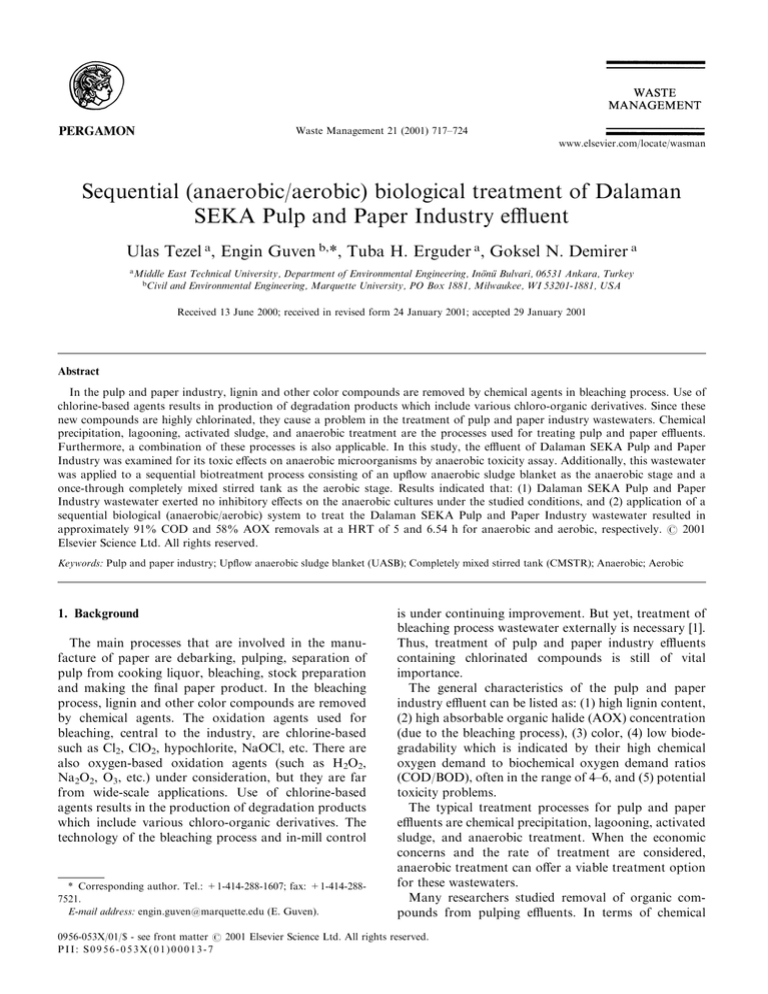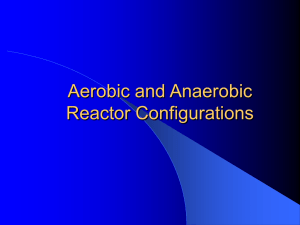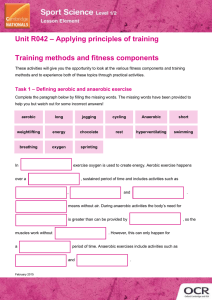
Waste Management 21 (2001) 717–724
www.elsevier.com/locate/wasman
Sequential (anaerobic/aerobic) biological treatment of Dalaman
SEKA Pulp and Paper Industry effluent
Ulas Tezel a, Engin Guven b,*, Tuba H. Erguder a, Goksel N. Demirer a
a
Middle East Technical University, Department of Environmental Engineering, Inönü Bulvari, 06531 Ankara, Turkey
b
Civil and Environmental Engineering, Marquette University, PO Box 1881, Milwaukee, WI 53201-1881, USA
Received 13 June 2000; received in revised form 24 January 2001; accepted 29 January 2001
Abstract
In the pulp and paper industry, lignin and other color compounds are removed by chemical agents in bleaching process. Use of
chlorine-based agents results in production of degradation products which include various chloro-organic derivatives. Since these
new compounds are highly chlorinated, they cause a problem in the treatment of pulp and paper industry wastewaters. Chemical
precipitation, lagooning, activated sludge, and anaerobic treatment are the processes used for treating pulp and paper effluents.
Furthermore, a combination of these processes is also applicable. In this study, the effluent of Dalaman SEKA Pulp and Paper
Industry was examined for its toxic effects on anaerobic microorganisms by anaerobic toxicity assay. Additionally, this wastewater
was applied to a sequential biotreatment process consisting of an upflow anaerobic sludge blanket as the anaerobic stage and a
once-through completely mixed stirred tank as the aerobic stage. Results indicated that: (1) Dalaman SEKA Pulp and Paper
Industry wastewater exerted no inhibitory effects on the anaerobic cultures under the studied conditions, and (2) application of a
sequential biological (anaerobic/aerobic) system to treat the Dalaman SEKA Pulp and Paper Industry wastewater resulted in
approximately 91% COD and 58% AOX removals at a HRT of 5 and 6.54 h for anaerobic and aerobic, respectively. # 2001
Elsevier Science Ltd. All rights reserved.
Keywords: Pulp and paper industry; Upflow anaerobic sludge blanket (UASB); Completely mixed stirred tank (CMSTR); Anaerobic; Aerobic
1. Background
The main processes that are involved in the manufacture of paper are debarking, pulping, separation of
pulp from cooking liquor, bleaching, stock preparation
and making the final paper product. In the bleaching
process, lignin and other color compounds are removed
by chemical agents. The oxidation agents used for
bleaching, central to the industry, are chlorine-based
such as Cl2, ClO2, hypochlorite, NaOCl, etc. There are
also oxygen-based oxidation agents (such as H2O2,
Na2O2, O3, etc.) under consideration, but they are far
from wide-scale applications. Use of chlorine-based
agents results in the production of degradation products
which include various chloro-organic derivatives. The
technology of the bleaching process and in-mill control
* Corresponding author. Tel.: +1-414-288-1607; fax: +1-414-2887521.
E-mail address: engin.guven@marquette.edu (E. Guven).
is under continuing improvement. But yet, treatment of
bleaching process wastewater externally is necessary [1].
Thus, treatment of pulp and paper industry effluents
containing chlorinated compounds is still of vital
importance.
The general characteristics of the pulp and paper
industry effluent can be listed as: (1) high lignin content,
(2) high absorbable organic halide (AOX) concentration
(due to the bleaching process), (3) color, (4) low biodegradability which is indicated by their high chemical
oxygen demand to biochemical oxygen demand ratios
(COD/BOD), often in the range of 4–6, and (5) potential
toxicity problems.
The typical treatment processes for pulp and paper
effluents are chemical precipitation, lagooning, activated
sludge, and anaerobic treatment. When the economic
concerns and the rate of treatment are considered,
anaerobic treatment can offer a viable treatment option
for these wastewaters.
Many researchers studied removal of organic compounds from pulping effluents. In terms of chemical
0956-053X/01/$ - see front matter # 2001 Elsevier Science Ltd. All rights reserved.
PII: S0956-053X(01)00013-7
718
U. Tezel et al. / Waste Management 21 (2001) 717–724
precipitation, depending on the coagulant and studied
wastewater (unbleached kraft effluent, bleached kraft
effluent, neutral sulphite semi-chemical, etc.), various
removal efficiencies (20–85% for AOX, 20–91% for
COD and 36–100% for color) were achieved [2–12]. A
three-stage chemical treatment using FeCl3, H2SO4, and
alum in successive stages resulted in a total BOD
reduction of 50%, with a turbidity reduction greater
than 82%, and a practically colorless effluent. All other
single coagulants or combinations of chemical coagulants resulted in lower BOD reductions [13]. It was also
reported that the percent AOX reduction by combined
chemical and biological treatment ranged from 53 to
59% depending on the operating conditions of the
biological treatment process [14].
In an aerated lagoon, 37% of the totally bound
chlorine and 24% of the non-purgeable organic carbon
(NPOC) were removed [15]. In another study, 32%
AOX removal was achieved in treatment of conventional mill wastewater by an aerated lagoon system [16].
The performance data for aerobic, facultative, and
anaerobic ponds are summarized for pulp and paper
wastewaters in Table 1 [17].
In an activated sludge plant treating kraft mill wastewater, 40–50% AOX and COD removals were achieved.
In another mill, which had a BOD loading of about
seven times higher than the former, a COD reduction of
34% and an AOX removal of 20–30% were achieved
[18]. A 70% COD removal in a UASB reactor was
reported [19]. Biological AOX removal was studied for
2 years and 30–35% removal for aerobic, 40–45% for
anaerobic and 50–55% removal for anaerobic–aerobic
sequential treatment were observed [20]. When two
reactor systems as two-stage bioreactors in series followed by a settler with solids recycle were studied, one
system was operated in an anaerobic-aerobic mode
(NA) and the second in an aerobic mode (AA). However, no obvious difference between NA and AA systems (57 and 59% removal of AOX, respectively) was
obtained [1].
Zitomer and Speece [21] stated that the ability of an
aerobically activated sludge process to reduce toxicity is
highly variable even when efficient suspended solids and
BOD removal is achieved. Anaerobic reactor followed
by aerobic reactor is more successful at reducing toxicity. Reductive dechlorination may occur in anaerobic
stage and produces less chlorinated organics. These
organics may be further biotransformed in conventional
aerobic stage [21]. In this study, a pulp and paper
industry effluent from Dalaman SEKA Pulp and Paper
Industry was examined for its toxic effects on anaerobic
microorganisms by anaerobic toxicity assay. Additionally, this wastewater was applied to a sequential biotreatment process consisting of an UASB as the
anaerobic stage and a once-through CMSTR as the
aerobic stage.
2. Materials and methods
2.1. Inocula
2.1.1. Municipal anaerobic digester sludge (MADS)
Municipal anaerobic digester sludge (MADS), which
was used in batch experiments, was obtained from
anaerobic digesters of the Ankara Municipal Wastewater Treatment Plant, Turkey. The digesters are
cylindrical in shape and made of concrete with a retention time of 14 days. The average flow of sludge from
primary thickeners to each digester is 805 m3/day. The
pH in the digesters ranges between 7.00 and 7.70.
Before using, the sludge was thoroughly mixed and
filtered through a screen with a pore size of 1 mm.
Where a more concentrated sludge was needed, it was
settled in an Imhoff cone for 24 h and the sludge
remaining under the supernatant was used.
2.1.2. Anaerobic granules
Anaerobic granules, which were used in the UASB
reactors, were obtained from the wastewater treatment
plant of Tekel Pasabahce Factory, Istanbul, Turkey.
The organic loading rate of the treatment plant is 30 kg
COD/m3 day with a flow of 60 m3/day. The pH of the
reactor ranges between 6.0–9.0.
2.1.3. Aerobic cultures
Aerobic cultures were obtained from the aeration
tanks of the activated sludge units of the Ankara
Municipal Wastewater Treatment Plant, Turkey, with a
sludge age and organic loading of 2.8 days and 165,000
kg BOD5/day, respectively.
Table 1
Performance of lagoon systems in treatment of pulp and paper wastewaters
Lagoon configuration
Area
(acres)
Depth
(ft)
Detention
(day)
Loading
(lb/acre day)
BOD5 removal
(%)
Aerobic — facultative
Anaerobic ponds
Aerobic — anaerobic
84
71
2520
5.0
6.0
5.5
10
18.4
136
157
347
28
87
50
94
U. Tezel et al. / Waste Management 21 (2001) 717–724
2.2. Pulp and paper effluent
Pulp and paper effluent (PPE) was obtained from
Dalaman SEKA Paper Industry, Turkey. During the
entire research, PPE was taken twice from the industry
(PPE-1, PPE-2). PPE-1 had a COD of 450–500 mg/l and
volatile suspended solids (VSS) concentration of
51 4.2 mg/l, whereas PPE-2 had a COD of 5500–6000
mg/l and VSS of 820 28.3 mg/l. Before using in the
continuous reactor experiments, the PPE was thoroughly mixed, strained through a 175-mm sieve and
stored in a 10-liter glass container.
2.3. Preparation of basal media
To supply necessary micro and macro nutrients and
alkalinity, basal media (BM) was used in the batch
experiment. The composition of the BM is as follows
(concentrations of the constituents are given in paranthesis as mg/l): NH4Cl (1200), MgSO4.7H2O (400),
KCl (400), Na2S.9H2O (300), CaCl2.2H2O (50),
(NH4)2HPO4 (80), FeCl2.4H2O (40), CoCl2.6H2O (10),
KI (10), MnCl2.4H2O (0.5), CuCl2.2H2O (0.5), ZnCl2
(0.5), AlCl3.6H2O (0.5), NaMoO4.2H2O (0.5), H3BO3
(0.5), NiCl2.6H2O (0.5), NaWO4.2H2O (0.5), Cysteine
(10), NaHCO3 (6000) [22].
719
2.4.5. Volatile fatty acids (VFA) and bicarbonate
alkalinity
Volatile fatty acids and bicarbonate alkalinity were
measured according to the titration procedure described
by Anderson and Yang [25].
2.4.6. Color
Color of the samples were measured by using a Hach
DR/2000 spectrophotometer operated at a wavelength
of 455 nm [24].
2.4.7. AOX
The AOX concentration of the samples was measured
by an analytical instrument containing boat control,
control, furnace, coulometer cell and micro coulometer
(Euroglas) units and a printer (Kipp & Zonen). After
filtering the samples through 0.45 mm filter paper the
procedure explained in ‘‘Manual for Determination of
AOX, POX and EOX’’ (1988) was followed.
2.5. Experimental set-up
2.4.3. Gas production
Gas production in serum bottles was measured using
a gas replacement device consisting of a 50-ml burette
with a water reservoir. A needle connected via latex
rubber tubing to the burette was inserted through the
serum bottle stopper, and the volume of the water displaced from the cylinder by gas was recorded. The
collected gas was vented after the measurement.
2.5.1. Batch experiment
In order to investigate the toxicity of the PPE-1 on
MADS, an anaerobic toxicity assay (ATA) experiment
was conducted as described by Demirer and Speece [22]
and Owens et al. [26].
The ATA experiment was performed in 125-ml serum
bottles capped with natural rubber sleeve stoppers.
MADS (10 ml )with a VSS of 14,925 35 mg/l and 10
ml of five times concentrated BM were inoculated into
the bottles. After 3–4 min purging with a mixture of
25% CO2 and 75% N2 gases for proper pH and anaerobic conditions, serum bottles were incubated in a
room that was maintained at 35 2 C. Acetic acid was
supplied as the primary substrate into the bottles. The
acetic acid concentration in the serum bottles was stochiometrically restored to 1050 mg/l daily depending on
the gas produced the previous day.
After observing steady state gas production (that is
when the daily variation in gas production is less than
10%) 5, 10, 20, 30 mL of PPE were injected into the
bottles. The total liquid volume in the bottles was completed to 50 ml by injecting tap water (Ankara, Turkey)
where necessary. All the control and test serum bottles
were run as duplicates. After spiking, the serum bottles
were monitored for 14 days.
2.4.4. COD
COD concentrations were determined according to an
EPA approved reactor digestion method [24]. A Hach
COD reactor and a Hach DR/2000 spectrophotometer
operated at a wavelength of 620 nm were used. COD
detection limit was 18 mg/l. Therefore, effluent COD
values of 0–18 mg/l corresponded to 100% COD
removal in calculations.
2.5.2. Continuously operated reactors
An Upflow Anaerobic Sludge Blanket (UASB) reactor was set up using a plexiglass column with an inner
diameter of 5.2 cm and length of 1 m with an effective
volume of 2.1 l. Anaerobic granules with a TVS of 280
g/l were placed into the reactor to a height of 27 cm.
Additionally, 1.35 m of 2 m wire given a spiral shape
was submerged into the sludge in order to facilitate the
2.4. Analytical Methods
2.4.1. Suspended solids (SS), volatile suspended solids
(VSS), total solids (TS) and total volatile solids (TVS)
SS, VSS, TS, and TVS were measured according to
Standard Methods 2540 [23].
2.4.2. pH
pH in samples was measured by a bench-top pH
meter (Jenway Ltd., Essex, UK) and a general purpose
pH electrode (Cole Parmer, Niles, IL,USA).
720
U. Tezel et al. / Waste Management 21 (2001) 717–724
Fig. 1. Schematic illustration of the reactor system.
release of gas produced and avoid sludge floating. Thus,
the effective volume of the reactor was 0.57 liters. Both
ends of the column were closed with cork covered by
Teflon tape. Teflon tubing was used at the inlet and
outlet of the reactor. All connectors used in the setup
were made of Teflon. The substrate was pumped continuously upwards into the reactor from the bottom.
There was no recycle. Longitudinal mixing was mainly
caused by rising gas bubbles and dispersion. The reactor
was placed in the temperature controlled room at
35 2 C (Fig. 1).
PPE was introduced to the reactor as the feed. However, in order to maintain sufficient alkalinity in the
influent, 2 g/l of NaHCO3 was added to the feed. COD,
volatile acids, bicarbonate alkalinity, liquid flow, pH,
and AOX were measured during the experiment.
A once through Completely Mixed Stirred Tank
Reactor (CMSTR) was included as the aerobic system at
the effluent of the UASB after 51 days in the test in order
to explore the effect on AOX and COD removal efficiency. The aerobic reactor consisted of a 1-liter plastic
container with an effective volume of 0.75 liter. Since no
sludge recycle was applied to the aerobic system, the
SRT of the aerobic system was equal to the HRT.
Aeration and mixing were maintained by a diffuser type
aerator delivering 800 standard ml/min air (Fig. 1). The
aerobic system was placed out of the temperature-controlled room where the temperature was 28 2 C. VSS
in the reactor was measured as 290 28 mg/l.
3. Results and discussion
3.1. Batch experiment
The purpose of the batch experiment was to obtain
general information on the toxicity of PPE-1. Five sets
of test bottles each containing two test bottles with the
same amount of wastewater were monitored over 14
days by adding acetic acid according to the gas produced the previous day. The mean daily gas production
in two bottles of each set tested was normalized by
dividing by the mean of the daily gas production in the
control set. The daily standard deviation of duplicate
bottles was less than 10% of the mean gas production.
Fig. 2. Normalized anaerobic toxicity assay results of pulp and paper
effluent.
U. Tezel et al. / Waste Management 21 (2001) 717–724
Such standard deviations indicate that the results
obtained are statistically dependable.
As shown in Fig. 2, no reduction in gas production
was detected for PPE-1. Therefore, it was concluded
that PPE-1 had no inhibitory effect on anaerobic
microorganisms under studied conditions. The increase
in gas production observed after the injection of 20 and
721
30 ml of PPE-1 may be caused by the additional organic
load from the wastewater.
3.2. Continuously operated reactors
Two different PPE samples were studied during the
experiment. The results obtained during the experiment
Fig. 3. Results obtained from continuous reactor experiments of PPE-1.
722
U. Tezel et al. / Waste Management 21 (2001) 717–724
are given in Figs. 3 and 4 for PPE-1 and PPE-2, respectively.
PPE-1 was fed to the UASB reactor for 35 days with
HRTs of 34, 17 and 8.6 h. When the HRT was 17 h. the
maximum COD removal (60%) and the maximum color
removal (46%) were achieved with 28% AOX removal.
Maximum AOX removal (45%), however, was obtained
with HRT of 34 h at which maximum COD and color
removals were 44 and 42%, respectively. VFA was also
monitored as an important indicator of the performance
of the reactor. The VFA values measured throughout
the experiments were very low indicating a proper
operation of the reactor (Fig. 3).
PPE-2 was introduced to the same UASB as PPE-1,
but this time an aerobic reactor was installed downstream. The UASB was operated with HRTs of 8.6 and
5 h whereas HRTs of the aerobic system were 11 and 6.5
h, respectively (Fig. 4). A maximum of 93% COD
Fig. 4. Results obtained from continuous reactor experiments of PPE-2.
U. Tezel et al. / Waste Management 21 (2001) 717–724
removal was achieved with 8.6 h HRT in the UASB
reactor. The addition of the aerobic reactor did not
affect the overall performance in terms of COD at Day
2. At 8.6 h HRT, AOX and color removals achieved
were 54 and 52%, respectively, in the anaerobic reactor.
An additional 5% removal of AOX was achieved in the
aerobic reactor (Day No. 2). A maximum of 85% COD,
50% AOX and 90% color removal were achieved at 5 h
HRT in UASB (Day No. 8). The aerobic reactor fed
with the effluent of UASB provided an additional 8%
AOX and 6% COD removal with 6.5 h HRT (Day No.
11). Thus, total removal increased to 91 and 58% in
terms of COD and AOX, respectively. However, that 5
h HRT adversely affected the system because of high
loading. Through the end of the experiment, efficiencies
in COD, color and AOX removal were decreased to 55,
30, 35%, respectively, in the UASB. No additional
removal was achieved in the aerobic reactor in terms of
COD and AOX, but 10% additional color removal was
still observed in the aerobic stage (Day No. 13).
Habets and Knelissen [19] reported 70% COD
removal in a UASB reactor at an organic loading rate of
19 g COD/l day and HRT of 2.5 h. In this study, at an
organic loading rate of 16 g COD/l day and 5 h HRT,
COD removal efficiencies of 85 and 91% were obtained
in UASB and at the end of aerobic stage, respectively
(Fig. 4). Moreover, highest AOX removal efficiencies
obtained were 52 and 58% in UASB and at the end of
aerobic stage respectively (Fig. 4). These results are
slightly higher but consistent with the results Ferguson
[20] reported.
4. Conclusions and recommendation
In this study, Dalaman SEKA Pulp and Paper
Industry’s wastewater, which contains chlorinated
organics, was examined for its toxicity under anaerobic
conditions and its treatability by a sequential UASB
and aerobic once-through CMSTR reactor configuration.
The following conclusions can be drawn according to
the experimental results obtained in this study:
1. Based on results of the anaerobic toxicity assay
(ATA) test, Dalaman SEKA Pulp and Paper
Industry wastewater exerted no inhibitory effects on
the anaerobic cultures under the studied conditions.
2. Application of a sequential biological (anaerobic/
aerobic) system to treat the Dalaman SEKA Pulp
and Paper Industry wastewater resulted in
approximately 91% COD and 58% AOX removals at a HRT of 5.0 and 6.5 h for anaerobic and
aerobic, respectively. AOX removal efficiency is
promising when compared with the separate
application of conventional aerobic and anaerobic
treatment. COD removal, on the other hand, is
723
sufficiently high when compared with the values
presented by the previous studies, which were stated before.
3. A color removal efficiency of 90% was achieved in
the anaerobic reactor at an HRT of 5.0 h. Addition of an aerobic reactor to the system did not
affect the color removal significantly. However,
90% color removal was also promising when the
values in previous studies considered.
Although such removal efficiencies were observed in
the study, a cost/benefit analysis should be conducted in
order to examine the feasibility of constructing sequential biological system to Dalaman SEKA Pulp and
Paper Industry other than the existing system or addition of chemical treatment system.
Acknowledgements
The authors gratefully acknowledge the valuable suggestions of Dr. Ulku Yetis, Dr. Celal F. Gokcay, Dr.
Filiz B. Dilek, Dr. Metin Duran and Dr. Daniel H.
Zitomer who contributed to this paper.
References
[1] Wang X, Mize TH, Saunders FM, Baker SA. Biotreatability test
of bleach wastewaters from pulp and paper mills. Wat Sci and
Tech 1997;35(2):101.
[2] Smith OD, Stein RM, Adams CE. Analysis of alternatives for
removal of suspended solids in pulp and paper mill effluents.
TAPPI Environmental Conference Denver, Col 1975;85.
[3] Nicolle FMA, Shamash R, Nayak KV, Histed JA. Lime treatment of bleachery effluent. Pulp Paper Canada 1977;78(T210).
[4] Dorica J, Wong A. Detoxification of linerboard effluents using
physical-chemical techniques. Pulp Paper Canada 1979;80(T80).
[5] Knocke WR, Bhinge D, Sullivan E, Boardman GD. Treatment of
pulp and paper wastewaters for potential water reuse. Proceedings of 41st Purdue Industrial Waste Conference. Lafayette, Ind.:
421, 1986.
[6] Bennett DH, Reeser D, Cambell AG, Falter CM. Pretreatment of
CTMP effluents by lime to reduce resin acids, sulphite, and toxicity. TAPPI Environmental Conference. Charleston, S.C: 199,
1988.
[7] Milstein O, Haars A, Majcherczk A, Trojanowski J, Tautz D,
Zanker H, Hutterman A. Removal of chlorophenols and chlorolignins from bleaching effluent by combined chemical and biological treatment. Wat Sci and Tech 1988;20:161.
[8] Almemark M, Ekengren, O. Physical/chemical treatment of
bleach-plant effluents with emphasis on chemical coagulation. 5th
Int. Symp. On Wood and Pulping Chemistry. Raleigh, NC: 27
(1989)
[9] Barton DA, Drake E, Hall TJ, Bousquet T. Physiochemical
treatment of bleach plant filtrates and final effluents for the
reduction of chlorinated organic compounds. TAPPI Environmental Conference. Richmond, Va: 821, 1992.
[10] Beulker S, Jekel M. Precipitation and coagulation of organic
substances in bleachery effluents of pulp mill. Wat Sci and Tech
1993;27:193.
724
U. Tezel et al. / Waste Management 21 (2001) 717–724
[11] Chernoberezhskii Yu. M, Barisheva IA, Tikhonava TV. Coagulation treatment of sewages of suphite pulping mills by prehydroyzed forms of aluminum. 4th IAWQ Symp. On Forest
Industry Wastewaters. Tampere, Finland, 1993.
[12] Savolainen M. Oxidative precipitation and air flotation of pulp
and paper mill effluents with ferrous sulphate and hydrogen peroxide (fennotriox). 4th IAWQ Symp. On Forest Industry Wastewaters. Tampere, Finland, 1993.
[13] Nemerow N.L. Liquid waste of industry — theories, practices,
and treatment. Addison-Wesley Pub. Com 1971.
[14] Francis DW, Turner PA, Wearing JT. AOX reduction of kraft
bleach plant effluent by chemical pretreatment- pilot-scale trials.
Wat Res 1997;31:2397.
[15] Bryant CW, Amy GL, Alleman BC. Organic halide and organic
carbon distribution and removal in a pulp and paper wastewater
lagoon. J Water Pollut Control Fed 1987;59:890.
[16] Gergov M, Priha M, Talka E, Valttila A. Chlorinated organic
compounds in effluent treatment at kraft mills. TAPPI Journal,
1988—Environmental Conference Proceedings: 443, 1988.
[17] Eckenfelder WW. Industrial water pollution control. 2nd ed.
McGraw- Hill, 1989.
[18] Fahmy M, Kut OM, Heinzle E. Anaerobic-aerobic fluidized bed
[19]
[20]
[21]
[22]
[23]
[24]
[25]
[26]
biotreatment of sulphite pulp bleaching effluents-I. Global parameters. Wat Res 1987;28(9).
Habets LHA, Knelissen JH. Application of the UASB-reactor for
anaerobic treatment of paper and board mill effluent. Wat Sci
and Tech 1985;17:61.
Ferguson JF. Anaerobic and aerobic treatment for AOX
removal. Wat Sci and Tech 1994;29(5):149.
Zitomer DH, Speece RE. Sequential environments for enhanced
biotransformation of aqueous contaminants. Environ Sci Technol 1993;27(2):227.
Demirer GN, Speece RE. Toxicity of acrylic acid to acetate-enriched Methanosarcina cultures. ASCE, J Environ Eng
1998;124(4):345.
APHA, AWWA and WEF standard methods for the examination of water and wastewater. Washington, DC, USA, 1998.
Water Analysis Handbook. Colorado: Hach Company, 1989.
Anderson GK, Yang G. Determination of bicarbonate and total
volatile acid concentration in anaerobic digesters using a simple
titration. Water Environ Res 1992;64(1):53.
Owen WF, Stuckey DC, Healy JB, Young LY, McCarty PL.
Bioassay for monitoring biochemical methane potential and
anaerobic toxicity. Wat Res 1979;13:485.




